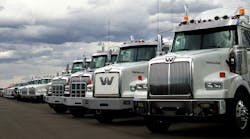With the creation of SmartWay and the implementation of Compliance, Safety, Accountability (CSA), the rules have changed for commercial vehicle maintenance. SmartWay opened the doors for countless devices and gadgets that claim to improve fuel efficiency and/or reduce emissions. CSA forced carriers to re-evaluate maintenance programs to ensure that all of the equipment is in good working order at all times. Like any initiative that originates in the halls of government, there are always some positives and some unintended consequences.
Tires and wheels are a natural target for SmartWay because they are major contributors to drag and fuel inefficiency. Most of the focus is on rubber compounds and tread designs. Their direct impact on low rolling resistance makes changes to them an easy way to improve fuel economy.
In some cases, tire manufacturers have used technology to create a genuinely efficient truck tire; in others, they rely on tactics like reducing tread depth to achieve the SmartWay designation. Given the absurd number of approved SmartWay tires, it’s obvious that either the bar is set too low, or the lack of policing makes it too easy to get creative with the test results.
The goal is not to criticize SmartWay because any improvement in fuel efficiency or reduced emissions is good for the industry and the planet. By encouraging fleets to explore ways to be more environmentally responsible, the industry is taking a step in the right direction. However, the quest for the SmartWay designation has led to some products that may have positive results, but the effects are either questionable or unknown.
One particular area where this is becoming an issue is the wheel cover. The theory is that by covering the open end of the wheel, drag will be reduced and efficiency improved. To the outside observer or SmartWay enthusiast, this makes perfect sense and would appear to be a no-brainer for a fleet looking to improve aerodynamics.
But the laws of unintended consequences are starting to have an impact on wheel covers. First of all, the methods for attaching them to the wheels need to be seriously considered. In some cases, the wheel cover could actually wear a groove in the rim surface and jeopardize the strength and integrity of the rim. In others, the lack of available training makes it difficult for technicians to determine the proper procedures and methods for removing and installing the wheel covers during normal service. Since methods are not the same, those procedures are product-specific and tend not to be communicated to the industry very well.
That being said, the most serious unintended consequence of wheel covers is probably the inability to visually inspect the wheels and fasteners. The Commercial Vehicle Safety Alliance (CVSA) is aware of the situation and is searching for a solution for obvious reasons. For one, enforcement officials are not going to remove a wheel cover during a roadside inspection. For another, the inability to visually inspect the wheel end for missing hardware, cracks or other damage presents a serious problem for those officials. There are no guidelines for officers to follow when wheel covers are present, but that could change in the near future.
Fleets that use wheel covers should start thinking about how they will react if CVSA establishes new guidelines for wheel end inspections. Does the product provide a way for officers to visually inspect the wheel? If not, are there any planned modifications that will allow for such an inspection?
Changes are probably coming at some point in the future because the inability to inspect the wheel end remains a problem that needs to be solved.


